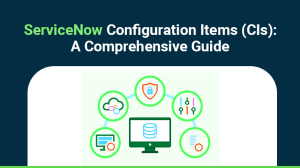As organizations become more dependent on technology to drive business operations, the complexity of IT environments continues to increase. The need for streamlined IT Operations Management (ITOM) has never been more pressing. From maintaining uptime to ensuring security and managing cloud infrastructure, IT teams are faced with the challenge of keeping operations running smoothly in an increasingly complex landscape.
ServiceNow is at the forefront of this transformation, offering an integrated platform that not only simplifies ITOM but also delivers unprecedented visibility, automation, and efficiency. In this blog post, we will explore how ServiceNow is transforming IT Operations Management, making IT teams more agile, proactive, and aligned with business goals.
What is IT Operations Management (ITOM)?
ITOM is a set of practices that manage and monitor IT services, infrastructure, and processes within an organization. It encompasses a range of activities, including configuration management, event management, discovery, orchestration, and cloud management. The goal of ITOM is to ensure the availability, reliability, and performance of IT services while optimizing resources and reducing operational costs.
Key Challenges in ITOM
Traditional IT operations often involve manual, siloed processes that are inefficient and error-prone. Some of the key challenges organizations face include:
- Lack of visibility into IT infrastructure and applications.
- Inconsistent workflows and manual processes that slow down response times.
- Disjointed tools that hinder collaboration between IT teams.
- Reactive IT management, which leads to prolonged outages and downtime.
- Difficulty in managing multi-cloud environments and hybrid infrastructures.
ServiceNow addresses these challenges head-on, offering a unified platform that enables organizations to manage IT operations more effectively.
ServiceNow’s Role in Transforming ITOM
ServiceNow transforms ITOM by providing a comprehensive suite of tools that streamline IT processes, automate workflows, and give IT teams complete visibility into their infrastructure. Let’s explore how ServiceNow is driving this transformation.
1. Unified Platform for IT Operations
One of ServiceNow’s core strengths is its ability to bring multiple ITOM functions onto a single platform. This eliminates the need for disjointed tools and enables IT teams to manage everything—from incident response to cloud management—through a single interface.
Key Benefits:
- End-to-end visibility into IT infrastructure, applications, and services.
- Integrated workflows that reduce the need for manual intervention.
- Seamless collaboration between IT teams like service management, security, and development.
This unified approach enables organizations to break down silos and ensure that IT operations are aligned with business objectives.
2. Automated Discovery and Service Mapping
Understanding the relationship between IT assets, applications, and services is critical for effective ITOM. ServiceNow’s Discovery and Service Mapping features automate the process of identifying and mapping IT infrastructure components and their dependencies.
How it Works:
- Discovery: Automatically detects hardware, software, cloud services, and virtual environments across on-premise and cloud infrastructure.
- Service Mapping: Visualizes the relationships between IT assets and business services, allowing IT teams to understand the impact of outages or changes in real-time.
Benefits:
- Accurate, up-to-date CMDB (Configuration Management Database): ServiceNow continuously updates the CMDB with data from Discovery and Service Mapping, ensuring that it reflects the current state of your IT environment.
- Faster incident resolution: With a clear understanding of dependencies, IT teams can quickly identify the root cause of incidents and resolve them faster.
- Change management optimization: Service Mapping helps organizations predict the impact of changes, reducing the risk of downtime during upgrades or migrations.
3. Proactive Event Management and Monitoring
Traditional IT operations tend to be reactive, addressing issues only after they cause disruptions. ServiceNow’s Event Management and Operational Intelligence transform this approach by enabling proactive monitoring and alerting.
Features of Event Management:
- Centralized event aggregation: Event Management consolidates alerts from various monitoring tools into a single dashboard, reducing alert fatigue.
- AI-powered insights: Operational Intelligence uses machine learning to detect anomalies and predict potential issues before they impact services.
- Automated response workflows: When an event is triggered, ServiceNow can automatically assign and escalate issues, ensuring timely resolution.
Benefits:
- Reduced downtime: By identifying and addressing issues before they escalate, organizations can significantly reduce downtime and improve service availability.
- Increased operational efficiency: Automation reduces the need for manual intervention, allowing IT teams to focus on strategic initiatives rather than firefighting.
- Better decision-making: With real-time insights into IT health and performance, IT leaders can make more informed decisions and prioritize resources more effectively.
4. Cloud Management and Orchestration
With the growing adoption of cloud services, managing multi-cloud environments has become a major challenge for IT operations teams. ServiceNow’s Cloud Management and Orchestration capabilities make it easier to manage, govern, and automate cloud resources across public, private, and hybrid environments.
Key Features:
- Cloud Resource Discovery: Automatically discover and inventory cloud assets across platforms like AWS, Azure, and Google Cloud.
- Self-service provisioning: IT teams can create workflows that allow users to request and provision cloud resources with proper governance.
- Cloud orchestration: Automate cloud operations, such as scaling resources or deploying applications, through predefined workflows.
- Cost management: ServiceNow provides insights into cloud usage and costs, helping organizations optimize cloud spending and avoid waste.
Benefits:
- Centralized cloud governance: ServiceNow provides a single interface to manage multiple cloud environments, ensuring consistency and security across platforms.
- Faster service delivery: Automating provisioning and orchestration accelerates service delivery, improving the user experience.
- Cost optimization: By gaining visibility into cloud usage and spending, organizations can optimize resource allocation and reduce costs.
5. AI and Machine Learning for Intelligent ITOM
ServiceNow incorporates artificial intelligence (AI) and machine learning (ML) capabilities into ITOM, helping organizations move toward predictive IT operations. These AI-driven insights enable IT teams to not only detect issues but also predict and prevent them before they impact the business.
Key AI/ML Features:
- Anomaly detection: ServiceNow’s Operational Intelligence continuously monitors data streams, identifying deviations from normal behavior and alerting teams to potential issues.
- Predictive analytics: AI models analyze historical data to predict future incidents, performance issues, or capacity constraints.
- Automated resolution: Based on past incident data, ServiceNow can suggest or automate the best course of action to resolve issues, reducing downtime.
Benefits:
- Proactive IT management: AI-driven insights allow IT teams to shift from reactive to proactive IT operations, reducing the frequency and impact of outages.
- Increased efficiency: Automation and predictive analytics reduce the time spent on manual monitoring and troubleshooting.
- Improved user experience: By preventing incidents before they occur, organizations can improve service reliability and user satisfaction.
6. ServiceNow’s Integration with DevOps
ServiceNow integrates seamlessly with DevOps practices, aligning IT operations with development and delivery processes. This integration enables continuous delivery, better collaboration between development and operations teams, and faster resolution of production issues.
Key Features:
- CI/CD Pipeline Integration: ServiceNow integrates with CI/CD tools like Jenkins, allowing changes to flow smoothly through development, testing, and deployment.
- Automated change approvals: ServiceNow automates change management approvals, ensuring that changes are deployed efficiently while minimizing risk.
- Incident and change visibility: With ServiceNow’s unified platform, IT teams can track the impact of changes on service performance and quickly address issues that arise in production.
Benefits:
- Faster time to market: By aligning ITOM with DevOps, organizations can accelerate the delivery of new features and services.
- Improved collaboration: Integration between development and IT operations breaks down silos, improving collaboration and reducing friction.
- Reduced downtime: Automation of change management processes minimizes the risk of human error, reducing downtime during deployments.
Conclusion
ServiceNow is revolutionizing IT Operations Management by providing a unified platform that delivers real-time visibility, automation, and proactive management. By leveraging advanced features like automated discovery, service mapping, AI-driven insights, and cloud orchestration, ServiceNow enables IT teams to move from reactive operations to proactive, predictive IT management.
This transformation not only reduces downtime and improves service reliability but also aligns IT operations with business goals, ensuring that technology becomes a driver of business success. With ServiceNow, organizations can optimize their IT resources, improve operational efficiency, and create a more resilient, agile IT environment capable of meeting the demands of the digital age.
Whether you’re just beginning your ITOM journey or looking to enhance existing operations, ServiceNow offers the tools and capabilities to take your IT operations to the next level.






